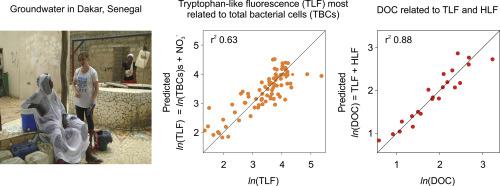Science of the Total Environment ( IF 9.8 ) Pub Date : 2020-05-19 , DOI: 10.1016/j.scitotenv.2020.139419 James P R Sorensen 1 , Mor Talla Diaw 2 , Abdoulaye Pouye 2 , Raphaëlle Roffo 3 , Djim M L Diongue 2 , Seynabou C Faye 2 , Cheikh B Gaye 2 , Bethany G Fox 4 , Timothy Goodall 5 , Daniel J Lapworth 6 , Alan M MacDonald 7 , Daniel S Read 5 , Lena Ciric 8 , Richard G Taylor 3

|
We explore in-situ fluorescence spectroscopy as an instantaneous indicator of total bacterial abundance and faecal contamination in drinking water. Eighty-four samples were collected outside of the recharge season from groundwater-derived water sources in Dakar, Senegal. Samples were analysed for tryptophan-like (TLF) and humic-like (HLF) fluorescence in-situ, total bacterial cells by flow cytometry, and potential indicators of faecal contamination such as thermotolerant coliforms (TTCs), nitrate, and in a subset of 22 samples, dissolved organic carbon (DOC). Significant single-predictor linear regression models demonstrated that total bacterial cells were the most effective predictor of TLF, followed by on-site sanitation density; TTCs were not a significant predictor. An optimum multiple-predictor model of TLF incorporated total bacterial cells, nitrate, nitrite, on-site sanitation density, and sulphate (r2 0.68). HLF was similarly related to the same parameters as TLF, with total bacterial cells being the best correlated (ρs 0.64). In the subset of 22 sources, DOC clustered with TLF, HLF, and total bacterial cells, and a linear regression model demonstrated HLF was the best predictor of DOC (r2 0.84). The intergranular nature of the aquifer, timing of the study, and/or non-uniqueness of the signal to TTCs can explain the significant associations between TLF/HLF and indicators of faecal contamination such as on-site sanitation density and nutrients but not TTCs. The bacterial population that relates to TLF/HLF is likely to be a subsurface community that develops in-situ based on the availability of organic matter originating from faecal sources. In-situ fluorescence spectroscopy instantly indicates a drinking water source is impacted by faecal contamination but it remains unclear how that relates specifically to microbial risk in this setting.
中文翻译:

原位荧光光谱表明总细菌丰度和溶解的有机碳。
我们探索原位荧光光谱法作为饮用水中细菌总数和粪便污染的瞬时指标。在补给季节之外,从塞内加尔达喀尔的地下水源中收集了84个样品。分析样品的色氨酸样(TLF)和腐殖质样(HLF)原位荧光,通过流式细胞仪检测的细菌细胞总数以及粪便污染的潜在指标,例如耐热大肠菌群(TTC),硝酸盐,以及22个样品中的一部分溶解有机碳(DOC)。显着的单因素线性回归模型表明,细菌总数是TLF最有效的预测因素,其次是现场卫生密度。TTC并不是重要的预测指标。包含总细菌细胞,硝酸盐,亚硝酸盐,现场卫生密度和硫酸盐的TLF的最佳多变量预测模型(r 2 0.68)。HLF类似地关系到相同的参数TLF,总细菌细胞是相关的最佳(ρ小号0.64)。在22个来源的子集中,DOC聚集了TLF,HLF和总细菌细胞,并且线性回归模型显示HLF是DOC的最佳预测因子(r 2 0.84)。含水层的颗粒间性质,研究时间和/或发给TTC的信号的不唯一性可以解释TLF / HLF与粪便污染指标(例如现场卫生密度和养分)之间的显着关联,而不能解释TTC。与TLF / HLF相关的细菌种群很可能是一个地下群落,其根据粪便来源有机物的可用性而就地发展。原位 荧光光谱可立即表明饮用水源受到粪便污染的影响,但目前尚不清楚在这种情况下饮用水源与微生物风险之间的关系。

































 京公网安备 11010802027423号
京公网安备 11010802027423号